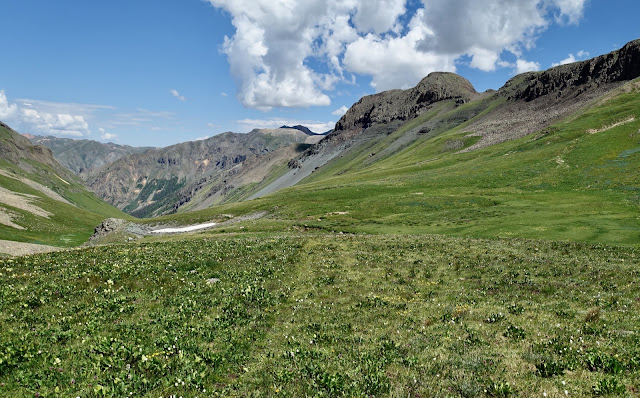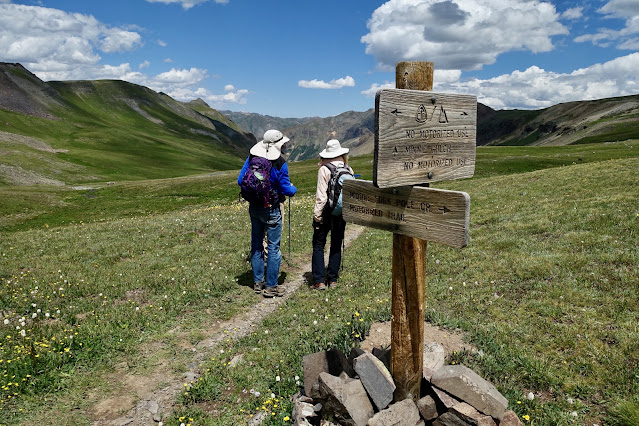Essence: Minnie Gulch is a sanctuary of silence, solitude, and contemplation. It is one of the very few high alpine valleys in the Silverton region without motorized use. In this wildlife haven, elk bugle, bighorn sheep browse, and mountain lions imprint the trail. Mid-summer, wildflowers are diverse and spectacular. Revel in tundra euphoria from your first step while ascending to two unranked prominences with broad picnic tops and big
cliffs off to one side. Summit views rival those found on much more challenging mountains. The beauty and ease of this hike make it one of the most sublime offerings on Earthline. Cuba Benchmark is on the boundary between the San Juan National Forest and Gunnison National Forest. The land to the west, including Minnie Gulch, is administered by the BLM. The southern portion of the hike is along the Continental Divide. The lands east of the divide are in the Rio Grande National Forest.
Travel: A 4WD (low helpful) vehicle with moderate clearance and sturdy tires are necessary to reach the trailhead. In Silverton, drive up Greene Street and zero-out your trip meter as you make a soft right onto San Juan County Road 2.
The pavement ends at 2.0 miles. On a good dirt road pass the turnoff to
Cunningham Gulch in Howardsville at 4.1 miles. Pass the road into
Maggie Gulch at 5.9 miles. Reach Minnie Gulch at 6.5 miles and turn
right onto San Juan CR 24. The steep, rocky, and very narrow road climbs switchbacks
before suspending itself on a shelf high above the gorge. In 7.8
miles, pass the first of many mine ruins and wreckage, some classically
picturesque. Bear right at the fork at 8.1 miles. Park at 9.5 miles. The road hooks left and ends in a tenth of a mile at a turnaround.
Distance and Elevation Gain: Cuba Benchmark: 6.9 miles, 1,650 feet. Point 13,100': add 1.3 miles, 250 feet.
Total Time: 3:00 to 4:00 for Cuba Benchmark. Add about an hour for Point 13,100'.
Difficulty: Trail, off-trail; navigation moderate; Class 2; no exposure
Map: Howardsville, Colorado 7.5' USGS Quad
Latest Date Hiked: July 21, 2022
Total Time: 3:00 to 4:00 for Cuba Benchmark. Add about an hour for Point 13,100'.
Difficulty: Trail, off-trail; navigation moderate; Class 2; no exposure
Map: Howardsville, Colorado 7.5' USGS Quad
Latest Date Hiked: July 21, 2022
Minnie Gulch Under Threat: In September, 2020, the Gunnison BLM Field Office approved
the Silverton Travel Management Plan. The most contentious part of the plan changes the designation of the
Minnie Gulch Trail from non-motorized to single-track motorized. The 1.6-mile dirt bike route would connect San Juan County Road 24 with a complex of Forest Service Roads on the east side of the Continental Divide. In December, 2020, San Juan Citizens Alliance and the Board of County Commissioners of San Juan County filed an appeal arguing for long-term protections of the scenic beauty, wildlife habitat, and cultural heritage in Minnie Gulch. There is significant and sufficient motorized use elsewhere across San Juan County. Establishing a motorized trail in Minnie Gulch would be incompatible with the nature and purposes of the Continental Divide National Scenic Trail. Further, the “Minnie Gulch Ute Trail” through the corridor is an important remnant of indigenous Ute travel routes at high altitude in the San Juan Mountains. As your tithe for wilderness, please consider making a donation to San Juan Citizens Alliance as they work to protect Minnie Gulch and other priority alpine habitats in the San Juan Basin.
Quote: The temple bell stops but I still hear the sound coming out of the flowers. Matsuo Bashō
Cuba Benchmark is a distinctive landmark on the east rim of Minnie Gulch.
Route: Walk southeast on-trail to the Continental Divide at the head of Minnie Gulch. Turn north on the shared Continental Divide and Colorado trails. Upon reaching the divide between Minnie and Cuba gulches, turn north and climb Cuba Benchmark. Walk south along the Continental Divide to Point 13,100'. Retrace steps to about 12,960 feet and cut west to link back up with the trail.
A sign indicates the Minnie Gulch Trail is closed to all
motorized vehicles. From the trailhead, elevation 11,560 feet, step across a stream and head up the footpath. Right from the start Point 13,100' is visible to the left of the pass, shown. In 2022, after weeks of daily monsoonal rain, the landscape was sopping wet. The main watercourse was ripping and riffing tunes that made our hearts sing.
This image looks back on the trailhead and parking. Most of the visible relics from the Esmeralda Mine (gold and silver) are near the incoming road and scattered on the hillsides.
Minnie Gulch has an abundance of wildlife. Songbirds sing, picas chirp, and yellow-bellied marmots whistle from all corners of the terrain. At ground level, burrow castings run through the soil. "Eskers" are made by pocket gophers under deep snow. Shown below is a mountain lion print near the beginning of the trail.
Wildflowers in Minnie Gulch typically peak in mid-July. Flora in the lower reaches of the valley include black tipped senecio and golden groundsel, Coulter's erigeron, Grey's angelica, geranium, potentilla, yarrow, pussy toes, western and edible valerian, sorrel, fairy candelabra, and psychedelic purple fringe. (Thomas Holt Ward, photo)
Half a mile up the trail the path wends through large boulders that have tumbled down the west slope of Cuba Benchmark. Living among the rocks are unusually pale columbine, veronica, alpine thistle, and purple Silverton wallflower.
In one mile, bluebells and delphinium spill down the hill along with rocks from an outcrop. This begins one of the consistently best floral displays in Colorado. The steep hillside between the trail and the stream is solid flowers.
Color swaths vary with a slight turn of the head. (THW, photo)
Deep maroon flower heads sparkle atop king's crown. Rose-colored queen's crown lives nearby in moist soil.
(THW, photo)
Cuba Benchmark is visible from different angles throughout this hike. Below, the flowing skirts of the prominence sport an astounding tapestry of Whipple's penstemon, also called dusky beardstongue.
The ascent up the draw is consistently pleasant and gradual. Below, a hiker ambles through a dense field of daffodil senecio. (THW, photo)
The trail disperses in the tundra at about 12,500 feet. A few cairns mark the route but the way is obvious to the pass.
Reach a major trail junction and the Continental Divide at the top of Minnie Gulch at 2.0 miles, 12,740 feet. The Continental Divide National Scenic Trail (CDT) shares the treadway in this region with the Colorado Trail (CT). There's a good chance you'll see backpackers and possibly bike-packers on these trails. The Middle Fork of Pole Creek Trail heads south. While it is open to motorized use, in over two decades I have never seen or even heard a "moto" on this trail.
As you head the gulch you will see a line of very tall cairns going in both directions marking Colorado's signature trail. From a distance it is hard to distinguish between a cairn and a human, perhaps giving rise to the name "stone boy." Our route goes northeast on the cross-state trail. Watch for a cairn on the right housing a marmot castle. Rock for the cairn pictured below was gathered conveniently from the island of stone upon which it was built.
Stand on the Cuba and Maggie Gulch divide at 2.8 miles, 12,900 feet. This will be a familiar location for those who have climbed Half Peak from the west. Shift onto a strong unmaintained trail that departs from the CDT/CT bearing north. The short run out to Cuba Benchmark is 1.3 miles roundtrip. Below, the benchmark is the first rounded knoll. (THW, photo)
It is rare to see people off the CDT/CT but common to see signs of wildlife. We heard trumpeting elk and saw cougar and coyote prints on the ridgeline. We were fortunate to find white fans rising from the soil--snowlover. On her website, Wildflowers of the Southern Rocky Mountains, Marilyn Phillips writes, “Even a walking pace is just too fast if we really want to see the world. Snowlover is one of those tiny alpine plants that evades you unless you search at the slowest pace. And then, as happened to us, you may find many snowlover plants, for the plants grow near each other by the dozen or more." (THW, photo)
To reach the benchmark, we stepped off the trail and walked up small runs of chipped talus to the saddle between the prominences, elevation 12,940 feet.
Since it was hard to determine which knoll was higher, we checked out the northern one first. It was an easy, short ascent through andesite, a fine-grained, extrusive igneous volcanic rock.
Looking north, we could see our past route to Crown Mountain, North Crown, and Niagara Peak. To the east of Niagara is Jones Mountain and American Peak. And finally, the highest of them all, Handies Peak.
Looking south, Cuba Benchmark is indeed the higher of the two companion knolls.
The USGS disk on the benchmark is unusual. "CUBA" was imprinted twice to get it right. There is no year noted, but there is an elevation, "13019."
The benchmark drops radically 1,500 feet into glacially carved Minnie Gulch where the trail is visible. The land punches back up to the Minnie and Maggie divide on Middle Mountain. Pyramidal Mount Sneffels is on the distant horizon, image-center. (THW, photo)
Alpine flowers are strewn about on the big broad crest. We found old man of the mountain, alpine avens, snowball saxifrage, candy tuft and smelowskia, sibbaldia, moss campion, and deep rooted spring beauty. Below, I'm looking toward singular Half Peak, 13,841', a 15.5 mile hike with 4,200 feet of elevation gain from the Minnie Gulch Trailhead. The hike requires a full day of untroubled weather. Cuba Benchmark is at the head of Cuba Gulch, an access route to Half Peak from Lake City. (THW, photo)
From the little crest, Point 13,100' is a carefree, contemplative walk across folds of green velvet. (THW, photo)
Point 13,100'
Return to the CDT/CT trail at 4.1 miles. Stroll south to Point 13,041', where you will once again be standing on the Continental Divide. Waters east of the ridge flow into Pole Creek. The all-important confluence with the Rio Grande River is but a few miles south.
This is a stretch of breath-taking immensity, quintessential Colorado tundra territory. We tagged all the rollers, searched for animal prints on the edges of ponds, and admired turquoise-colored veins in chunks of quartz.
We found a few Colorado ragwort and one uncommon Colorado tansy aster. The blossoms of alpine sandwort (formally minuartia) are even tinier than they appear in this image. (THW, photo)
Point 13,100' is a neglected, unranked prominence passed up by hikers walking east-west across the state, or north-south across the country. In its favor, the little bluff looks out over the greatest division of waters in America. Below, the CDT/CT zigzags up the slope toward Stony Pass. Canby Mountain to the southwest is right on the Continental Divide. Sheep Mountain with the linear summit ridge sheds into the headwaters of the Rio Grande.
Below, two friends look further afield and deeper in time to the 1.5 billion-year-old, mind-bending Precambrian basement rock in the quartzite Grenadier Range. When you must break away, retrace your steps until you are past the westward scree runners and simply cut down to the CDT/CT. (THW, photo)

































2 comments:
This looks great!
Minnie Gulch is NOT closed to dirtbiked BLM has this trail wrong. ✌️
Post a Comment